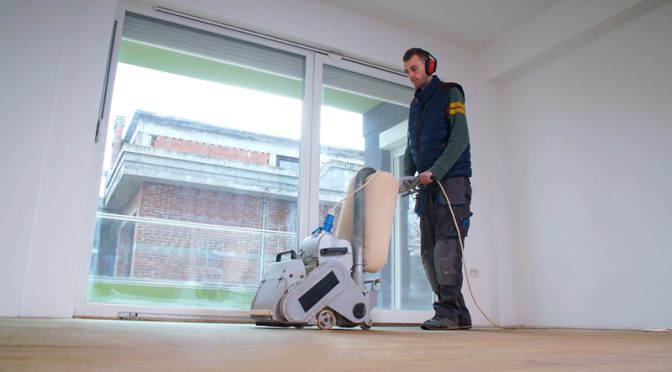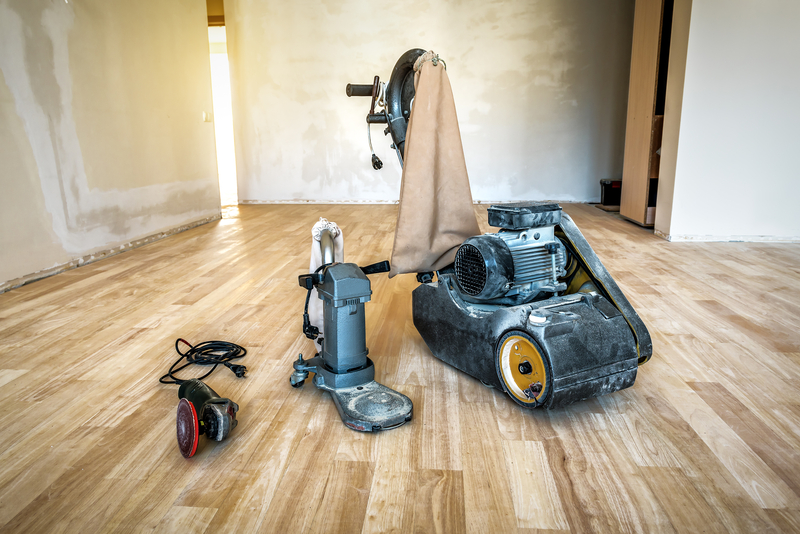Revitalising wooden floors is a transformative process that breathes new life into your interior spaces. Central to this endeavour is the art of floor sanding, which strips away imperfections and prepares the surface for a fresh, polished finish. However, achieving a flawless sanding job requires the right tools – and that’s where floor sanders come into play.
These powerful machines are designed to tackle the nuances of different wood surfaces, ensuring a smooth and consistent finish. From the heavy-duty muscle of drum sanders to the finesse of orbital sanders, each type of floor sander serves a distinct purpose.
Let’s explore different types of sanders, equipping you with the knowledge to choose the right tool and each floor sander uses for your specific project and providing expert tips on their effective usage.
Overview of Floor Sanders
Floor sanders are essential tools in the world of wood floor refinishing. These machines harness the power of abrasive materials, such as sandpaper, to smooth and level the surface of wooden floors. By removing old finishes, stains, and imperfections, floor sanders prepare the surface for a fresh, pristine finish.
Choosing the right floor sander is crucial, as different types of sanders are designed to tackle various tasks and floor conditions. From aggressive material removal to delicate final touches, each sander offers distinct advantages and limitations. Understanding these nuances is key to achieving a flawless, professional-grade finish.
Different Types of Floor Sanders
Floor sanding is an important task in the process of redesigning your wood floors. To achieve a flawless finish, it is crucial to understand the
1. Drum Sanders
Drum sanders are the heavy-duty workhorses of the floor sanding world. Featuring a large cylindrical drum onto which sandpaper is attached, these sanders are designed to make quick work of even the most challenging surfaces. As the drum rotates at high velocity, it aggressively removes material, tackling deep scratches, stains, and unevenness with ease.
Pros and Cons of Drum Sanders
| Pros | Cons |
|---|---|
| Extremely efficient at aggressive material removal | Requires a high level of skill and experience to operate properly |
| Can tackle deep scratches, stains, and significant unevenness | Aggressive nature increases risk of gouging or damaging floors |
| Perfect for intensive renovation projects on heavily damaged floors | Not well-suited for delicate finishing work |
When to use?
Drum sanders are the go-to choice for significant renovation projects where a substantial amount of material needs to be removed. They excel at smoothing out heavily worn, stained, or uneven floors, preparing them for a fresh start.
2. Orbital Sanders
Orbital sanders offer a gentler approach to floor sanding, making them ideal for finer work and final finishes. Unlike drum sanders, these machines feature a square or rectangular sanding pad that vibrates in small, elliptical motions. This orbital action allows for a smooth and controlled sanding process, minimising the risk of accidental gouging or over-sanding.
Pros and Cons of Orbital Sanders
| Pros | Cons |
|---|---|
| Gentler sanding action reduces the risk of accidental damage | Relatively slow at removing significant amounts of material |
| Easy to manoeuvre and beginner-friendly | May not be powerful enough for heavily damaged floors |
| Provides a smooth, refined finish ideal for final stages | Relatively slow at removing significant amounts of material |
When to use?
Orbital sanders are the perfect choice when you need a smooth, consistent finish, especially on delicate surfaces like parquet or inlaid floors. They are also ideal for the final sanding stages, ensuring a refined and polished look before applying the finishing coats.
3. Belt Sanders
Belt sanders, also known as strip sanders, are a versatile option for floor sanding. These machines feature a continuous loop of sandpaper that rotates around two drums, allowing for efficient material removal. Belt sanders are particularly effective on softwood surfaces and for levelling out uneven areas.
Pros and Cons of Belt Sanders
| Pros | Cons |
| Efficient at levelling uneven surfaces and removing material | Require moderate experience to avoid patterns or gouging |
| Versatile for use on both rough and smooth wood surfaces | Not as aggressive as drum sanders for heavy-duty removal |
| Can be used for trimming and edging tasks in addition to broad areas | Can be difficult to manoeuvre compared to smaller sanders |
When to use?
Belt sanders are versatile tools that can be employed throughout the sanding process, from initial material removal to final smoothing. They are particularly useful for levelling out uneven or raised areas on softer wood floors.
4. Edging Sanders
As the name suggests, edging sanders are designed to tackle the areas that larger sanding machines cannot reach – the edges and corners of a room. These handheld tools allow for precise sanding along baseboards, corners, and other tight spaces, ensuring a uniform finish throughout the entire floor.
Pros and Cons of Edging Sanders
| Pros | Cons |
| Extremely precise for sanding along edges, corners and tight spaces. | Limited to edge work only, cannot sand broad open floors |
| Compact size allows access to hard-to-reach areas. | Require cautious handling to prevent accidental damage |
| Often include dust collection to minimise airborne particles. | It may leave visible lines or patterns if not used skillfully |
When to use?
After completing the main floor area with a drum or orbital sander, edging sanders become essential for achieving a seamless, consistent finish along the room’s perimeter. Their precision makes them indispensable for the final touches.
5. Detail Sanders
Detail sanders, also known as palm sanders, are compact and lightweight tools designed for intricate sanding tasks. With their small size and ergonomic design, they offer unparalleled control and manoeuvrability, making them ideal for detailed work and touch-ups.
Pros and Cons of Detail Sanders
| Pros | Cons |
| Compact and lightweight for maximum manoeuvrability | Very limited surface area coverage not suited for broad spaces |
| Ideal for intricate sanding work and touch-ups | Require frequent sandpaper changes on larger jobs |
| Can be used for rough removal or fine-finishing stages | Easy to apply too much pressure and cause divots if not careful |
When to use?
Detail sanders are versatile tools that can be employed throughout the sanding process. They are particularly useful for sanding corners, edges, and other hard-to-reach areas, as well as for touch-ups and final finishing tasks.
Choosing the Right Floor Sander
With the diverse array of floor sanders available, selecting the best sander for floors and tools for your specific project is crucial. Here are some key factors to consider:
Floor condition
Heavily damaged, uneven, or stained floors may require the aggressive material removal capabilities of a drum sander, while lightly worn floors can be handled with gentler options like orbital sanders or detail sanders.
Flooring material
Hardwood floors may require more robust sanders, while softer woods or delicate surfaces like parquet or inlaid floors call for gentler tools like orbital sanders.
Project size
Large open spaces may benefit from the efficiency of drum sanders or belt sanders, while smaller rooms or intricate areas are better suited for edging sanders or detail sanders.
Desired finish
If you’re aiming for a smooth, polished finish, consider combining the power of a drum sander with the finesse of an orbital sander or detail sander for the final touches.
How to Use Floor Sanders Effectively
Using floor sanders effectively requires a combination of knowledge, skill, and proper safety precautions. Here are some tips for getting the most out of your sanding tools:
- Prepare the area: Clear the room of furniture and any loose debris, and cover any vents or openings to prevent dust from spreading throughout the house.
- Wear protective gear: Always wear safety goggles, a dust mask or respirator, ear protection, and protective clothing to avoid exposure to dust and debris.
- Start with the right sandpaper grit: Begin with a coarse grit (e.g., 24 or 36 grit) for heavily damaged or uneven floors, and gradually progress to finer grits (e.g., 60, 80, or 100 grit) as you approach the final sanding stages.
- Follow the manufacturer’s instructions: Carefully read and follow the instructions for your specific floor sander model to ensure proper operation and safety.
- Sand in the right pattern: For drum and belt sanders, work in overlapping passes, moving along the grain of the wood. For orbital and detail sanders, use a consistent back-and-forth motion.
- Vacuum frequently: Regularly vacuum up dust and debris during the sanding process to prevent it from being ground back into the floor surface or spreading throughout the room.
- Be mindful of edges and corners: Use edging sanders or detail sanders to carefully sand along baseboards, corners, and other tight spaces that larger machines can’t reach.
- Take breaks: Sanding can be physically demanding, so take frequent breaks to avoid fatigue, which can lead to mistakes or injuries.
- Finish with the finest grit: For the final sanding, use the finest grit sandpaper (e.g., 100 grit or higher) to achieve a smooth, uniform surface ready for refinishing.
- Clean up thoroughly: After sanding, thoroughly vacuum and clean the area to remove all dust and debris before applying any finishes or sealants.
Common Questions About Floor Sanders
What are the different types of floor sanders used for?
The main types of floor sanders include drum sanders (for aggressive material removal), orbital sanders (for smooth finishes), belt sanders (for levelling and softwood floors), edging sanders (for corners and edges), and detail sanders (for intricate work and touch-ups).
- What type of floor sander should I use?
The appropriate floor sander depends on the condition of your floor, the type of wood, the project size, and the desired finish. Heavily damaged floors may require a drum sander, while lightly worn floors can be sanded with an orbital or detail sander.
- Which one do I need – drum sander vs orbital sander?
Drum sanders are ideal for aggressive material removal on heavily damaged or uneven floors, while orbital sanders are better suited for achieving a smooth, consistent finish on lightly worn floors or for final finishing stages.
- Is orbital or belt sander better for floors?
Orbital sanders are generally the best floor sander for hardwood floors, as they provide a smoother, more controlled finish. Belt sanders are more commonly used on softwood floors and for levelling out uneven areas.
Revive your wooden floors with Floor Sanders London
Refurbishing wooden floors is a rewarding endeavour, but achieving a flawless finish requires the right tools and techniques. By understanding the different types of floor sanders and their specific uses, you can select the most appropriate tools for your project and ensure a seamless, professional-grade result.
Remember, safety should always be a top priority when working with powerful sanding equipment. Wear appropriate protective gear, follow manufacturer instructions, and take necessary precautions to minimise the risk of accidents or injuries.
If you’re unsure about the best approach for your floor sanding project or need professional assistance, don’t hesitate to reach out to Floor Sanders London. Our team of experts can provide valuable guidance and top-quality sanding services to help you achieve the beautiful, long-lasting wooden floors you desire.6552


